The Grumman G-118 was a design for an all-weather missile-armed interceptor aircraft for use on US Navy aircraft carriers. Originally conceived as an uprated F11F Tiger, it soon evolved into a larger and more powerful project. Although two prototypes were ordered in 1955, development was cancelled the same year in favor of the F4H Phantom II before any examples were built. Grumman's next carrier fighter would be the F-14 Tomcat, ordered in 1968.

The Vought XF3U was the prototype of a two-seat, all-metal biplane fighter, built by Vought Aircraft Company of Dallas, Texas for the United States Navy.

The Berliner-Joyce XFJ was a United States prototype biplane fighter aircraft that first flew in May 1930. Designed by Berliner-Joyce Aircraft for the United States Navy, its lower wing, placed below the fuselage and just two feet above the ground, apparently gave it a tendency to ground loop when landing, and it was never ordered for production.

The Boeing XF6B-1 / XBFB-1 was Boeing's last biplane design for the United States Navy. Only the one prototype, Model 236, was ever built; although first flying in early 1933, it rammed into a crash barrier in 1936 and the design was not pursued further.
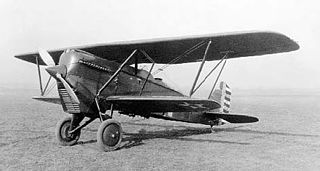
The Boeing XP-7 was a prototype United States biplane fighter of the 1920s.
The Hawker P.V.3 was a British single-engined biplane fighter prototype of the 1930s. Only a single example was built, the Gloster Gladiator being selected instead to fulfill the requirement to which it was designed.

The Eberhart XFG was an American single-seat experimental ship-borne biplane fighter aircraft developed for the United States Navy in 1927 by the Eberhart Aeroplane and Motor Company. The sole prototype was rebuilt into the XF2G with the addition of a single float and a different engine, but the aircraft was destroyed in a crash in 1928, and the type did not enter production.

The Berliner-Joyce XF3J was an American biplane fighter, built by Berliner-Joyce Aircraft. It was submitted to the United States Navy for their request for a single-seat carrier-based fighter powered by a 625 hp (466 kW) Wright R-1510-26 engine.
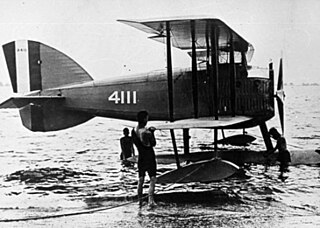
The Curtiss HA was an American biplane seaplane designed by Captain B.L. Smith of the United States Marine Corps, and built by Curtiss Aeroplane and Motor Company.

The Curtis XF13C was a carrier-based fighter aircraft built by Curtiss Aeroplane and Motor Company.

The Douglas XFD was a carrier-based biplane fighter aircraft designed for the United States Navy, and the first fighter to be built by the Douglas Aircraft Company. A victim of changing requirements, no production was undertaken.

The Loening PA-1 was an American fighter aircraft prototype built by Loening Aeronautical Engineering.
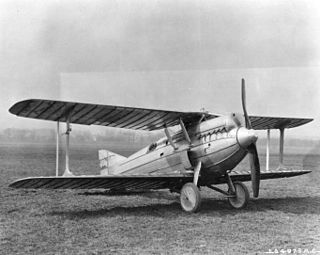
The Gallaudet PW-4 was a prototype biplane fighter aircraft built by the Gallaudet Aircraft Company. It was one of the last projects by the company before it was taken over by Consolidated Aircraft. It was all-metal and powered by a Packard 11A-1237 engine. Three prototypes were ordered by the USAAC, but the company could afford to build only one, which never flew.
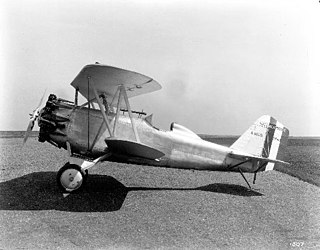
The Hall XFH was an American fighter aircraft built by the Hall Aluminum Company. It was the first fighter with a semi-monocoque metal fuselage.

The Navy-Wright NW series, also called the Mystery Racer were racing aircraft built by Wright Aeronautical Corporation at the request of the US Navy. Although innovative, both prototype racers were lost before achieving their true potential.
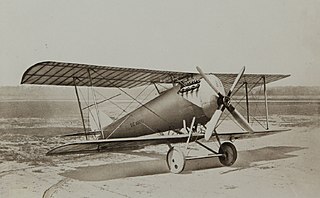
The Pomilio FVL-8 was a biplane fighter aircraft built by Fabbrica Aeroplani Ing. O. Pomilio for Engineering Division of the Aviation Section, U.S. Signal Corps.

The Wright XF3W was an American racing aircraft built by Wright Aeronautical for the United States Navy.

The Northrop XFT was an American prototype fighter aircraft of the 1930s. A single engined low-winged monoplane, it was designed and built to meet a United States Navy order for an advanced carrier based fighter. It exhibited poor handling, and was rejected by the Navy, the single prototype being lost in a crash. A variant, the Northrop 3A, also was unsuccessful.

The Rogožarski SIM-XIV-H was a 1930s Yugoslav coastal reconnaissance floatplane and light bomber, twin-engined, with three crew members. It was designed and built at the Rogožarski factory in Belgrade.

The Thomas-Morse TM-24 was a prototype American two-seat observation aircraft of the 1920s. A single example was built in 1925, but no production followed.


















